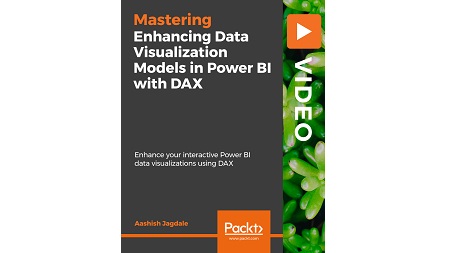
English | MP4 | AVC 1920×1080 | AAC 48KHz 2ch | 3h 44m | 2.62 GB
Interpret your business data seamlessly by enhancing your data visualizations in Power BI via DAX
Microsoft’s Power BI is one of the most powerful business intelligence tools on the market. It provides actionable information about your company’s data through appealing dashboards and visualizations. To present insightful visualizations, you need to perform statistical operations and data-crunching. That’s how DAX (Data Analysis Expressions) boosts Power BI functionalities. Through its library of functions and operators, you can build formulas and expressions to simplify that task.
In this course, you will use Power BI with DAX to transform your company’s data into a visualization to better understand and interpret your data. You will begin by understanding the limitations of your data, then clean it to make it available for the right dataset. You will be creating required workspaces on the web and learning new (and updating existing) development skills using DAX. Enhance your data models for normal and advanced calculations to create interactive reports using the large set of visualizations that are available.
Toward the end of the course, you will monitor your business data to get rapid answers via rich dashboards and visualizations available on every device.
Learn
- Become an advanced Power BI user by enhancing your data visualization models via DAX
- Transform your company’s data into rich visuals with Power BI to monitor your business and get answers quickly
- Clean data and create relevant, interactive, and presentable visuals to provide key stakeholders with developing dashboards
- Collect data from databases and use CSV files to write queries with Power BI
- Create interactive reports using the large set of visualizations available in Power BI
- Define advanced calculations using DAX expressions to ensure enhanced data modeling
- Explore different options for creating, managing, and sharing your dashboards and visualizations with Power BI
- Portable and flexible and can be used on multiple systems, making it accessible at any time
Table of Contents
Manage your Data
1 The Course Overview
2 Creating Datasets in the Power BI Desktop
3 Analyzing the Dataset
4 Ensuring Your Data Is Clean and Easy-to-Read
Introduction to DAX
5 Overview of DAX
6 DAX Data Types and Operators
7 Working with DAX Functions and Formulas
Writing Queries to Load Data
8 Overview of Supported Data Sources
9 Loading Data versus Using DirectQuery
10 Working with Composite Models
11 Transforming Data
12 Joining or Combining Queries
13 Writing Power Query Functions
14 Working with Power Query Parameters
Improving Your Data Model
15 Renaming Columns and Tables
16 Hiding Columns and Tables From the Data Model
17 Column Data Type and Formatting
18 Working with Numerical Fields
19 Creating Computed Columns with DAX
20 Sorting Data in Columns and Data Categorization
21 Defining Hierarchies Based on a Single Table
22 Defining Relationships Between Tables
Enhancing the Data Model Using DAX
23 Referencing Other Tables in DAX
24 Row Versus Filter Context
25 Using CALCULATE
26 Some Useful DAX Functions
27 Adding Time Intelligence Using DAX
Working Around Workspaces
28 Creating New Workspace Apps
29 Managing Workspaces and Apps
30 Sharing Dashboards with Internal and External Users
31 Creating Power BI Apps
32 Consuming Power BI Apps
33 Using Publish to Web with Dashboards
34 Course Summary
Resolve the captcha to access the links!